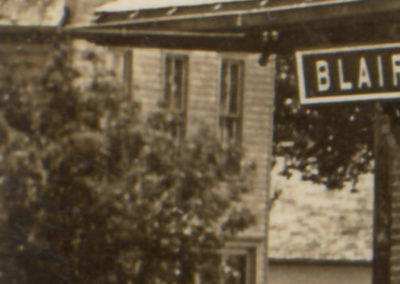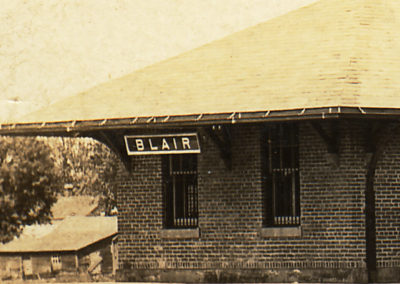Home > Archive > Railroad Depots > 1910 Depot
1910 Blair Brick Depot

Built: 1910
Located: North of the corner of 14th & Front Streets
Current occupant: October 19, 1987
Related Links
In 1910, a new brick depot was built and it is this building that many of the local people today refer to as “The Old Depot” just north of the corner of 14th & Front Streets.
Its unique design was planned to fit into the “Y” created by two merging railroad tracks. Its elegant interior, with its tiled floors, served many passengers before the last passenger train June 3, 1950. The building stayed empty on the Union Pacific lot until October 19, 1987 when it was quickly demolished with little input from the local citizens.
The tracks through Blair still carry heavy west bound traffic.
Newspaper article on the depot's demolition
From The Blair Enterprise, Thursday, Oct 22, 1987 Pages 1 & 3
County Surprised with quick demolition of Blair depot
On Monday morning, October 19th, a heavy duty bulldozer, a crane with a clam shell bucket and about a dozen railroad persons and trucks moved on the old Blair railroad depot at 14th and Front Streets. By the end of the day the depot was only a memory and a pile of broken lumber and bricks.
Very few people in Blair knew that the old depot was going to be demolished. The necessary permits were in order and the building was reduced to rubble before anyone could object to the old landmark being destroyed.
The old depot had been the center of Blair’s commerce back about 80 years ago. Passenger
trains and freight trains made that location the most important spot for everything from shipping eggs and cream out to even bringing political figures into the area at election times.
Telegraph service was one of the main jobs of the 24 hour per day depot. Railroad crews were also stationed in Blair for many years before the Chicago and Northwestern moved the section headquarters to Missouri Valley, Iowa several years ago. The old depot was used only for storage for about the last five years. Many local persons thought the old depot could have been sold for such purpose as a unique type of restaurant. A railroad employee said that the company did not want to sell the building because it was too close to the main line and the liability risk was great. The main line runs about 20 feet north of the old depot. Trains are speeding past the site about every 30 minutes with even more train traffic planned for the future. As a result the railroad company decided that the building had to be destroyed to eliminate maintenance costs for a building that they no longer needed.
The old “Blair” stone sign, that was mounted on the north side of the depot, was saved. The railroad is planning to put the sign into a permanent mounting in the future.
Depot history
History of the Blair Depot is sketchy, at best. The first railroad in Blair was the Sioux City and Pacific Railroad, and they set up shop in Blair 1876. That was not the first line, however. In 1867, a railroad company did lay a line from DeSoto to Fremont that came through Blair. The Sioux City and Pacific Railroad did much to improve the City of Blair, according to early records. Efforts included building a combination depot and hotel on the site of the present D.L. Blair building. That depot was moved in later years to just south of the Blair Feed Mill, who still uses it for storage. Across the street from the old depot, where the current US Post Office is, was a park laid out by the railroad company. A date is not known when the recently demolished depot was built, but the Blair Newspapers are in possession of pictures dating back to 1911. The following is a history of railroads in Washington County, written in the centennial year of the United States, 1876. The history was written by John T. Bell, a law reporter from Omaha.
Railroads
THE SIOUX CITY & PACIFIC, OMAHA & NORTHWESTERN, AND ELKHORN VALLEY RAILROADS.
In 1864 was organized the Northern Nebraska Air Line Railroad Company, but nothing was done in the way of constructing a road. In 1867, the company was reorganized, consisting of John S. Bowen, John A. Unthank, Dean C. Stader, Jessie T. Davis and T.P. Kennard, the object being to build a railroad from DeSoto to Fremont. A land grant of seventy-five sections of land was donated the company by the State, in aid of the enterprise, and a temporary line was built from DeSoto to the present site of Blair. In 1868, the company disposed of Its franchise to John T. Blair and associates, who, the following year, completed the Sioux City & Pacific road from the Missouri Immediately east of Blalr to Fremont, there forming a Junction with the Union Pacific and Elkhorn Valley roads. A year or two afterwards the DeSoto branch, or “plug” as it was called in derision, was taken up, having never been operated. Considerable bad feeling was gotten up among, the residents of the county In consequence of this abandonment of the original design to make DeSoto the eastern terminus of the road, in Washington County, but that soon passed off. County aid to the amount of $75,000 was, voted the Sioux City & Pacific road, in 1869. This road has been successfully operated ever since its completion. Mr. Scott Bryan is agent for the company in Blair.
The Elkhorn Valley road does not run through Washington county, but is built in the valley of the Elkhorn river, on the west side of the stream, from Fremont to Wisner, affording railroad transportation to the western portion of the county, the river being bridged.
A look back at the Blair depot
by Dale Gentzler
In its heyday, the Blair railway depot was a veritable hub of activity, affecting nearly everyone in Blair and the surrounding territory in one way or another. Businesses got much of their merchandise by rail, farmers’ livestock and grain were shipped by rail, salesmen went from town to town on trains, and passenger traffic was heavy. Several trains arrived and left town many times a day. Townspeople met every train that pulled in, some to meet friends and relatives, some to pick up merchandise from the Railway Express car, and some just out d curiosity.
The arrival d the automobile took its toll on the rail business. – Folks found it easier. to get from one place to another by automobile and they could go when they wanted to go. Merchants learned that they could rely upon trucks for faster and better service.
As railroads modernized their equipment, they found that fewer stations were needed, and consequently fewer employees. Main lines received the bulk of the upkeep needed and soon the branch lines began to deteriorate and the railroads closed depot after depot, and, eventually, entire branches. The huge brown water tanks and windmills that dominated the sky lines d every small town along the way, became useless with the arrival of diesel engines, and they, too, were torn down.
Telegraph lines were later replaced by radios and telephones. .4t one time every depot had its telegrapher, usually the depot agent, who copied train messages and passed them on to the trainmen, or delivered Western Union telegrams which were sent by Morse code.
Doing the relief shift
I came involved in railroading about 1950, which proved to be the beginning of the decline of the Nebraska Division of the Chicago and Northwestern. One of my first permanent assignments, after working for a few years as a relief agent, was the relief telegrapher’s job at the Blair depot, a position. I held for only a couple years.
The depot was open twenty-four hours a day at that time, and my job was to work the three other operators’ days off. Consequently I worked two days a week from four to midnight, two days from midnight to eight and on Sunday from 8 a.m. until 4 p.m. Passenger traffic was already a thing d the past here, but the number of trains passing through Blair warranted the station’s full-time operation.
We still took Western Union messages and all train messages, over the telegraph wires.
There was a considerable amount of carload traffic and there were always a number of cars on the sidings, waiting to be unloaded, or empty ones waiting to be picked up. An agent-telegrapher’s duties included keeping a record of all these cars, and seeing that all business got taken care of.
Fancy depot
As depots went, Blair’s was a nice one. Most C&-NW depots were those brownish-red frame affairs, usually two-story buildings which housed the office and freight room on the main level, with living quarters upstairs for the resident agent. The bathroom was usually a rustic edifice out back, and it served the public as well as the depot people.
Blair’s depot was a brick one-story building that sat in the vee formed by the crossing of two railroads. The depot office windows faced the tracks-in the vee, and there was a waiting room on both sides of the office, running parallel to the two sets of tracks. One was told that one had been a men’s waiting room and the other a women’s, but I suspect that it was more likely a different waiting room for the respective railroads. When I arrived on the scene, one waiting room was boarded off, but one could tell it had been quite an establishment in the early days. There were marble floors in both waiting rooms, and there was indoor plumbing, of all things.
Two railroads.
The two railroads that crossed in front of the depot were the C&NW and the CStPMSO. The Chicago, St. Paul, Minneapolis and Omaha was owned by the Chicago and Northwestern at this time and this branch line ran from Omaha to points north. The C&-NW came across the Missouri River from the east and joined the main line at Fremont. The two lines were connected by another track east of Blair, forming, what was known as a “Y”, which actually was more like a triangle. The “Y” was used when trains coming from Omaha needed to go east instead of continuing on north, or vice versa. It was also utilized in turning trains around. Some terminals had a round-house to turn engines around, but the Blair “Y” served the same purpose. The engineer simply proceeded [sic] around one side of the triangle, backed up the next, and was then in position to go back where he came from.
Somewhere along the line, the need for a full-time operator disappeared, probably due more to the advent of the radio than to anything else. Messages could now be sent directly to the men on the train. There has been a single agent at the depot in recent years, but the upkeep d such a building just for that purpose does seem to be unnecessary.
The end of an era
It’s too late now, but one has to wonder if any attempt was made by the railroad, or local officials, to salvage this building. It played such an important part in the history of the City of Blair, it’s too bad it couldn’t have been kept as a museum, or a business of some sort. If local people weren’t notified of the depot’s being torn down, they should have been.
1910 Blair Train Depot
Photo taken from the north west showing the tracks in foreground and the west end for freight. Original Photo Post Card, from the collection of Nathan Krämer. Scanned 2006/Catalog No. DPT-0006
1910 Blair Train Depot – Details
Photo taken from the east showing the tracks on the north side. Digital scan from calendar in the archive of Pounds Printing, Inc. (Original Photo unknown)/Catalog No. DPT-0004
1910 Blair Train Depot
Photo taken from the north east showing the tracks in foreground and brick structure behind. 1496px X 1046px Digital scan on file acquired from E Gentzler (Original unknown)/Catalog No. DPT-0003
1910 Blair Train Depot
Photo looking West/Southwest at the Blair Depot built in 1910. This picture is from 1922. Note the old 1880 wooden depot just to the right in the distance. Real Photo Post Card from the Washington County Historical Association Collection./Catalog No. DPT-0005
1910 Blair Train Depot
Photo taken from the west showing the tracks on the north side. The picture was from the 1960s or 1970s. 1356px X 1020px Digital scan on file acquired from E Gentzler (Original unknown)/Catalog No. DPT-0002
1910 Depot – Interior
Photo showing the west side of the depot. Original Photo Posted Card at the Washington County Historical Association/Catalog No. DPT-0001
1910 Blair Train Depot
South West Side of the 1910 Brick Passenger Depot. The water tower stood on the north side of the tracks to the east. Real Photo Post Card from Pat Tripp Collection/Catalog No. DPT-0018
Adjust the text size



Featured Pictures
Archive Links
BHPA Links
Blair Historic Preservation Alliance | P.O. Box 94 | Blair, Nebraska 68008 | contact@blairhistory.com





























